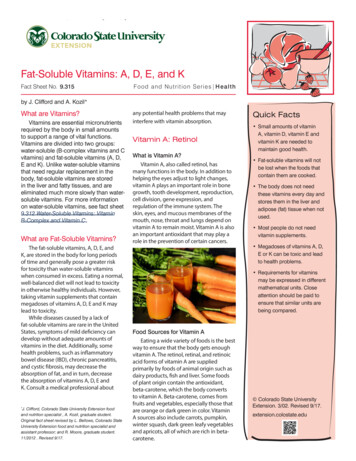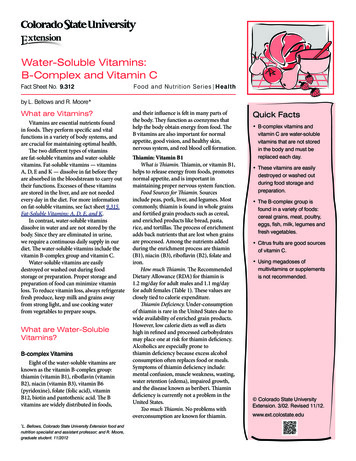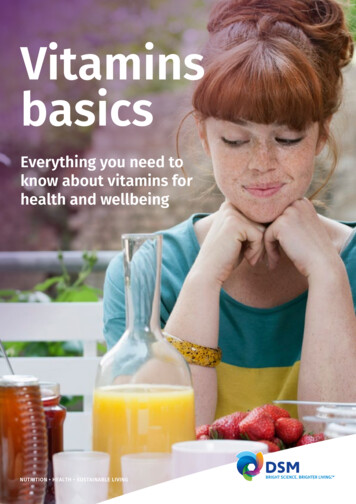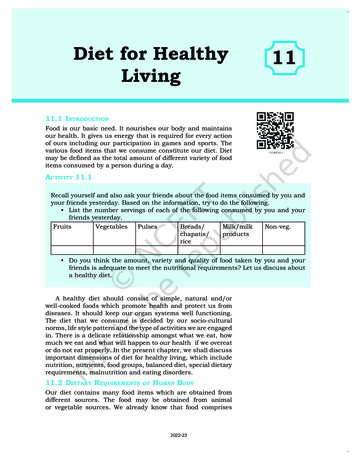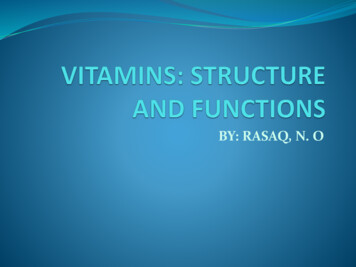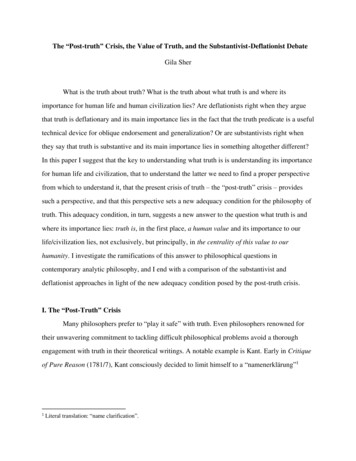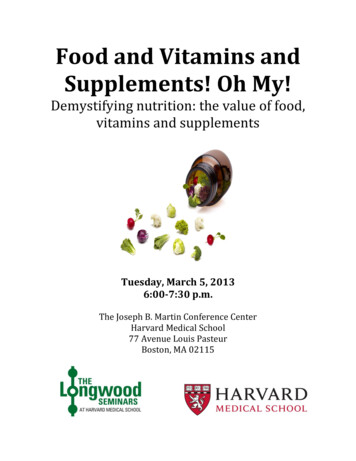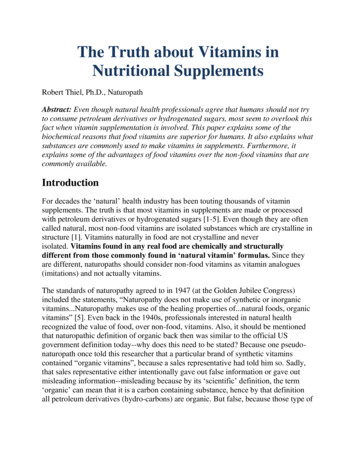
Transcription
The Truth about Vitamins inNutritional SupplementsRobert Thiel, Ph.D., NaturopathAbstract: Even though natural health professionals agree that humans should not tryto consume petroleum derivatives or hydrogenated sugars, most seem to overlook thisfact when vitamin supplementation is involved. This paper explains some of thebiochemical reasons that food vitamins are superior for humans. It also explains whatsubstances are commonly used to make vitamins in supplements. Furthermore, itexplains some of the advantages of food vitamins over the non-food vitamins that arecommonly available.IntroductionFor decades the ‘natural’ health industry has been touting thousands of vitaminsupplements. The truth is that most vitamins in supplements are made or processedwith petroleum derivatives or hydrogenated sugars [1-5]. Even though they are oftencalled natural, most non-food vitamins are isolated substances which are crystalline instructure [1]. Vitamins naturally in food are not crystalline and neverisolated. Vitamins found in any real food are chemically and structurallydifferent from those commonly found in ‘natural vitamin’ formulas. Since theyare different, naturopaths should consider non-food vitamins as vitamin analogues(imitations) and not actually vitamins.The standards of naturopathy agreed to in 1947 (at the Golden Jubilee Congress)included the statements, “Naturopathy does not make use of synthetic or inorganicvitamins.Naturopathy makes use of the healing properties of.natural foods, organicvitamins” [5]. Even back in the 1940s, professionals interested in natural healthrecognized the value of food, over non-food, vitamins. Also, it should be mentionedthat naturopathic definition of organic back then was similar to the official USgovernment definition today--why does this need to be stated? Because one pseudonaturopath once told this researcher that a particular brand of synthetic vitaminscontained “organic vitamins”, because a sales representative had told him so. Sadly,that sales representative either intentionally gave out false information or gave outmisleading information--misleading because by its ‘scientific’ definition, the term‘organic’ can mean that it is a carbon containing substance, hence by that definitionall petroleum derivatives (hydro-carbons) are organic. But false, because those type of
vitamins are not organic from the true naturopathic, or even the U.S. government’s,perspective.Officially, according to mainstream science, “Vitamins are organic substances that areessential in small amounts for the health, growth, reproduction, and maintenance ofone or more animal species, which must be included in the diet since they cannot besynthesized at all or in sufficient quantity in the body. Each vitamin performs aspecific function; hence one cannot replace another. Vitamins originate primarily inplant tissues” [6]. Isolated non-food ‘vitamins’ (often called ‘natural’ or USP orpharmaceutical grade) are not naturally “included in the diet”, do not necessarily“originate primarily in plant tissues”, and cannot fully replace all natural vitaminactivities. As a natural health professional, you should be able to read and interpret,even misleading supplement labels. For those who are unsure, hopefully this articlewill provide sufficient information to determine if vitamin tablets are food orimitations.What is Your Vitamin Really?Most vitamins in supplements are petroleum extracts, coal tar derivatives, andchemically processed sugar (plus sometimes industrially processed fish oils), withother acids and industrial chemicals (such as formaldehyde) used to process them [15]. Synthetic vitamins were originally developed because they cost less [7]. Assumingthe non-food product does not contain fish oils, most synthetic, petroleum-derived,supplements will call their products ‘vegetarian’, not because they are from plants, butbecause they are not from animals. Most vitamins in vitamin supplements made fromfood are in foods such as acerola cherries, broccoli, cabbage, carrots, lemons, limes,nutritional yeast, oranges, and rice bran (some companies also use animal products).Table 1. Composition of Food and Non-Food Vitamins [1-10]VitaminFood Nutrient*‘Natural’ Vitamin Analogue & Some ol, benzene, petroleum esters; acetylene;refined oilsVitamin B-1Nutritional yeast, ricebranCoal tar derivatives, hydrochloric acid;acetonitrole with ammoniaVitamin B-2Nutritional yeast, ricebranSynthetically produced with 2N acetic acidVitamin B-3Nutritional yeast, riceCoal tar derivatives, 3-cyanopyridine; ammonia
branand acidVitamin B-5Nutritional yeast, ricebranCondensing isobutyraldehyde with formaldehydeVitamin B-6Nutritional yeast, ricebranPetroleum ester & hydrochloric acid withformaldehydeVitamin B-8RicePhytin hydrolyzed with calcium hydroxide andsulfuric acidVitamin B-9Broccoli, rice branProcessed with petroleum derivatives and acids;acetyleneVitamin B-12Nutritional yeastCobalamins reacted with cyanideVitamin ‘B-x’PABA NutritionalyeastCoal tar oxidized with nitric acid (fromammonia)CholineNutritional yeast, ricebranEthylene and ammonia with HCL or tartaric acidVitamin CAcerola cherries,citrus fruitsHydrogenated sugar processed with acetoneVitamin DNutritional yeastIrradiated animal fat/cattle brains or solventlyextractedVitamin ERice, vegetable oilsTrimethylhydroquinone with isophytol; refinedoilsVitamin HNutritional yeast, ricebranBiosynthetically producedVitamin KCabbageCoal tar derivative; produced with p-allelicnickel* Note: Although some companies use liver extracts as a source for vitamins A and/orD, and at least one company has a herring oil product supplying some vitamin E, nocompany this researcher is aware of whose products are made out of 100% food useanimal products in any of their multiple vitamins. Some companies also use brewer’syeast which is inferior to nutritional yeast in many ways (including the fact that it hasnot had the cell wall enzymatically processed to reduce possible sensitivities).Read The Label to See the Chemical Differences!
Although many doctors have been taught that food and non-food vitamins have thesame chemical composition, this is simply untrue for most vitamins. As shown intable 2, the chemical forms of food and synthetic nutrients are normally different.Health professionals need to understand that since there is no mandated definition ofthe term ‘natural’; just seeing that term on a label does not mean that the supplementcontains only natural food substances. One of the best ways to tell whether or not avitamin supplement contains natural vitamins as found in food is to know thechemical differences between food and non-food vitamins (sometimes called USPvitamins). Because they are not normally in the same chemical form as vitamins foundin foods, non-food vitamins should be considered by natural health professionals asvitamin analogues (artificial imitations), and not actually as true vitamins for humans.Table 2. Chemical Form of Food and Non-Food Vitamins [1-10]Primary Chemical VitaminForm in FoodVitamin Analogue Chemical Form (Often CalledNatural*)Vitamin A/Betacarotene; retinylesters; mixed carotenoidsVitamin A acetate; vitamin A palmitate; betacarotene(isolated)Vitamin B-1; thiaminpyrophosphate (food)Thiamin mononitrate; thiamin hydrochloride; thiamin HCLVitamin B-2; riboflavin, multipleforms (food)Riboflavin (isolated); USP vitamin B2Vitamin B-3; niacinamide (food)Niacin (isolated); niacinamide (isolated)Vitamin B-5; pantothenate (food)Pantothenic acid; calcium pantothenate; panthenolVitamin B-6; 5’0 (beta-D)pyridoxinePyridoxine hydrochloride; pyridoxine HCLVitamin B-9; folateFolic acidVitamin B-12; in; hydroxycobalaminCholine (food); phosphatidylcholine (food)Choline chloride; choline bitartrateVitamin C; ascorbate (food);dehydroascorbateVitamin D; mixed forms,Ascorbic acid; most mineral ascorbates (i.e. sodiumascorbate)Vitamin D1 (isolated); Vitamin D2 (isolated); Vitamin D3
primarily D3 (food)(isolated) ; Vitamin D4; ergosterol (isolated);cholecalciferol (isolated); lumisterolVitamin E; RRR-alpha-tocopherol(food)Vitamin E acetate; Mixed tocopherols; all-rac-alphatocopherol; d-l--alpha-tocopherol; d-alpha-tocopherol(isolated); dl-alpha-tocopheryl acetate; all acetate formsVitamin H; biotinAll non-yeast or non-rice vegetarian biotin formsVitamin K; phylloquinone (food)Vitamin K3; menadione; phytonadione; naphthoquinone;dihydro-vitamin K1* Note: This list is not complete and new analogues are being developed all the time.Also the term “(isolated)” means that if the word “food” is not near the name of thesubstance, it is probably an isolate (normally crystalline in structure) and is not thesame as the true vitamin found in food.Read the label of any supplement to see if the product is truly 100% food. If even oneUSP vitamin analogue is listed, then the entire product is probably not food (normallyit will be less than 5% food). Vitamin analogues are cheap (or not so cheap) imitationsof vitamins found in foods.Beware of any supplement label that says that its vitamins are vegetarian andcontain no yeast. This researcher is unaware of any frequently used vegetariannon-yeast way to produce vitamin D or many of the B vitamins, therefore, if alabel states that the product “contains no yeast” then in pretty much all cases,this demonstrates that the product is synthetic or contains items so isolated thatthey should not be considered to be food.Saccharomyces cerevisiae (the primary yeast used in baking and brewing) isbeneficial to humans and can help combat various infections [11], including accordingto the German E monograph Candida albicans. In the text, Medical Mycology JohnRippon (Ph.D., Mycology, University of Chicago) wrote, “There are over 500 knownspecies of yeast, all distinctly different. And although the so-called bad yeasts doexist, the controversy in the natural foods industry regarding yeast related to healthproblems which is causing many health-conscious people to eliminate all yeastproducts from their diet is ridiculous.? It should also be noted, that W. Crook, M.D.,perhaps the nation’s best known expert on Candida albicans, wrote, “yeasty foodsdon’t encourage candida growth.Eating a yeast-containing food does not makecandida organisms multiply” [12]. Some people, however, are allergic to the cell-wallof yeast [12] and concerned supplement companies which have nutrient-containingyeast normally have had the cell-wall enzymatically processed to reduce even thisunlikely occurrence.
Food Vitamins are Superior to Non-Food VitaminsAlthough many mainstream health professionals believe, “The body cannot tellwhether a vitamin in the bloodstream came from an organically grown cantaloupe orfrom a chemist’s laboratory” [13], this belief is quite misleading for several reasons.First it seems to assume that the process of getting the amount of the vitamin into thebloodstream is the same (which is frequently not the case [3-10]). Secondly, scientistsunderstand that particle size is an important factor in nutrient absorption even thoughparticle size is not detected by chemical assessment. Thirdly, scientists alsounderstand that, “The food factors that influence the absorption of nutrients relate notonly to the nature of the nutrients themselves, but also their interaction with eachother and with the nonabsorbable components of food” [14]. Fourthly, “thephysiochemical form of a nutrient is a major factor in bioavailability” (and food andnon-food vitamins are not normally in the same form) [15]. Fifthly, most non-foodvitamins are crystalline in structure [1].Published scientific research has concluded, “natural vitamins are nutritionallysuperior to synthetic ones” [8].Food vitamins are in the physiochemical forms which the body recognizes, generallyare not crystalline in structure, contain food factors that affect bioavailability, andappear to have smaller particle sizes (see illustrations in table 3). This does not meanthat non-food vitamins do not have any value (they clearly do), but it is important tounderstand that natural food complex vitamins have actually been shown to be betterthan isolated, non-food, vitamins (see table 4).Look at Electronic Photos to See the Structural DifferencesElectronic photos demonstrate that isolated USP vitamins have a crystallineappearance compared to vitamins in foods which have more of a rounded appearance(see table 3).Table 3. Physical and Structural DifferencesFood Vitamin CAscorbic Acid
Food Vitamin B1Thiamine HydrochlorideElectronic PhotographsEven before these types of pictures were available, the late Dr. Royal Lee knew thatfood vitamin C was superior to ascorbic acid. “Dr. Lee felt it was not honest to use thename ‘vitamin C’ for ascorbic acid. That term ‘should be reserved for the vitamin CCOMPLEX’” [16]. Why then, according to the ingredients listed in a recent catalog,would a supplement company that Dr. Lee originally founded currently includeascorbic acid, inorganic mineral salts, and/or other isolated nutrients in the majority ofits products? Dr. Lee, like the late Dr. Bernard Jensen [17], was also opposed to theuse of other isolated, synthetic, nutrients [16].Dr Lee specifically wrote, “In fact, the Food & Drug laws seem to be suspendedwhere synthetic imitations of good foods are concerned, and actually perverted toprosecute makers and sellers of real products The synthetic product is always asimple chemical substance, while the natural is a complex mixture of related andsimilar materials Pure natural Vitamin E was found three times as potent as puresynthetic Vitamin E. Of course the poisonous nature of the synthetic Vitamin D iswell established. WHY DO NOT THE PEOPLE AND MEDICAL MEN KNOWTHESE FACTS? Is it because the commercial promoters of cheap imitation food anddrug products spend enough money to stop the leaking out of information?” [18].Table 4. Comparison of Certain Biological Effects of Food and Non-FoodVitaminsFood VitaminVitamin AVitamin BVitamin B-9Vitamin CVitamin DVitamin EVitamin HCompared to USP/’Natural’/Non-Food VitaminsMore complete, as scientists teach that vitamin A is not an isolate [19]Complex More effective in maintaining good health and liver function [20,21]More utilizable above 266mcg (Recommended Daily Intake is 400mcg) [22]Over 15.6 times antioxidant effect [23]Over 10 times the antirachitic effect [24]Up to 4.0 times the free radical scavenging strength [25]Up to 100 times more biotin effect [1]
Vitamin KSafer for children [26]The difference is more than quantitative.Let’s take vitamin C for an example. Even if one were to take 3.2 times as much ofthe so-called natural, non-food, ascorbic acid than food vitamin C, although theantioxidant effects might be similar in vitro, the ascorbic acid still will not containDHAA [1], nor will it ever have negative oxidative reductive potential (ORP). An invitro study performed at this researcher’s lab with a digital ORP meter demonstratedthat a citrus food vitamin C has negative ORP, but that ascorbic acid had positiveORP [27].It takes negative ORP to clean up oxidative damage [28], and since ascorbic acid haspositive ORP (as well as positive redox potential [1]), it can never replace foodvitamin C no matter what the quantity! Furthermore, foods which are high in vitaminC tend to have high Oxygen Radical Absorbance Capacity (ORAC, another test whichmeasures the ability of foods and other compounds to subdue oxygen free radicals[23]). A US government study which compared the in vivo effects of a high vitamin Cfood (containing 80 mg of vitamin C) compared to about 15.6 times as much isolatedascorbic acid (1250 mg) found that the vitamin C-containing food produced thegreatest increase in blood antioxidant levels (it is believed that bioflavonoids andother food factors are responsible) [23].Furthermore, it is even possible isolated ascorbic acid only has in vitro and no invivoantioxidant effects: “it has not been possible to show conclusively that higher thananti-scorbic intake of {SYNTHETIC} vitamin C has antioxidant clinical benefit” [29].Why should people take supplemental synthetic ascorbic acid when it is NOT beenproven to have antioxidant effects in humans?“Cross sectional and longitudinal studies show that the occurrence of cardiovasculardisease and cancer is inversely related to vitamin C intake the protective effects seenin these studies are attributable to fruit and vegetable {FOOD} intake In general,beneficial effects of supplemental {SYNTHETIC} vitamin C have been noted insmall studies, while large well controlled studies have failed to show benefit” [29].The other quantitative is that in humans, “Plasma is completely saturated in doses of400 mg and higher daily producing a steady-state plasma concentration of 80mM Tissues, however, saturate before plasma” [29]. De-emphasizing vitamin Ccontaining foods by attempting to consume higher quantities of isolated ascorbic acidsimply will not have the effects on plasma vitamin C levels, ORP, ORAC, or otherhealth aspects that many consumers of isolated ascorbic acid hope it will [3,27,29].No matter how much isolated ascorbic acid one takes orally
It will never saturate plasma and/or tissue vitamin C levels significantly morethan can be obtained by consuming sufficient vitamin C containing foods.It will never have negative ORP, thus can never ‘clean-up’ oxidative damagelike food vitamin C can.It will never have the free radical fighting capacity of food vitamin C.It will never contain DHAA (the other ‘half’ of vitamin C) or the promotingfood factors.It will never have the same effect on health issues, such as aging andcardiovascular disease as high vitamin C foods can.It will not ever be utilized the way food vitamin C is.It will always be a synthetic.Let’s take vitamin E as another example—the body has a specific liver transport forthe type of vitamin E found in food [10]—it does not have this for the syntheticvitamin E forms (nor for the ‘new’ vitamin E analogues that are frequentlymarketed)—thus no amount of synthetic vitamin E can truly equal food vitamin E—the human body actually tries to rid itself of synthetic vitamin E as quickly as possible[30]. As another example, it should be understood that certain forms of vitaminanalogues of B-6 [19], D [10], and biotin [1] have been shown to have almost novitamin activity.Fractionated, synthetic, vitamins do not replace all the natural function of foodvitamins in the body. This is due to the fact that they are normally chemically andstructurally different (they also do not have the naturally occurring food factors whichare needed by the body) from vitamins found in foods (or vitamin supplements madeup entirely of foods).Food Vitamins and Non-Food Vitamin AnaloguesVitamin A/Betacarotene: Vitamin A naturally exists in foods, but not as a singlecompound. Vitamin A primarily exists in the form of retinyl esters, and not retinol andbeta carotene is always in the presence of mixed carotenoids with chlorophyll [10].Vitamin A acetate is from methanol, it is a retinol which is crystalline in structure [1].Vitamin A palmitate can be fish oil [1] or synthetically derived [2]; but once isolatedit bears little resemblance to food and can be crystalline in structure [1,2]. Syntheticbetacarotene is “prepared from condensing aldehyde (from acetone) with acetylene”[2]; “not much natural beta-carotene is available due to the high costs of production”[2].“Beta-carotene has been found to have antioxidant effect in vitro Whether{ISOLATED} beta-carotene has significant antioxidant effect in vivo is unclear” [32].Carrots, a food high in betacarotene, do have high antioxidant ability [32,33]. Natural
betacarotene, as found in foods, is composed of both all-trans and 9-cis isomers, whilesynthetic betacarotene is all-trans isomers [34]. Carrots, yellow and green leafyvegetables, and turmeric contain natural betacarotene along with multiple carotenoids.Natural betacarotene was found to significantly decrease serum conjugated dienelevels for children exposed to high levels of irradiation, though it is not known ifsynthetic betacarotene would provide similar benefits [34].Regarding isolated betacarotene, “The data presented provide convincing evidence ofthe harmful properties of this compound if given alone to smokers, or to individualsexposed to environmental carcinogens, as a micronutrient supplement” [35]. “Thethree beta-carotene intervention trials: the Beta Carotene and Retinol Efficacy Trial(CARET), Alpha-Tocopherol, Beta-Carotene Cancer Prevention Study (ATBC), andPhysician's Health Study (PHS) have all pointed to a lack of effect of synthetic betacarotene in decreasing cardiovascular disease or cancer risk in well-nourishedpopulations. The potential contribution of beta-carotene supplementation to increasedrisk of lung cancer in smokers has been raised as a significant concern. The safety ofsynthetic beta-carotene supplements and the role of isomeric forms of beta-carotene(synthetic all-trans versus "natural" cis-trans isomeric mixtures) have becometopics of debate in the scientific and medical communities” [36]. Now, although theconsumption of both synthetic betacarotene and food betacarotene raise serum vitaminA levels about the same, this obscures the fact that synthetic betacarotene tends tomainly increase serums all-trans betacarotene, while food betacarotene increases otherforms as well [37].It is possible that synthetic betacarotene can negatively affect vitamin E’s antioxidantability as a clinical study found, “These results support earlier findings for theprotective effect of a-tocopherol against LDL oxidation, and suggest that betacarotene participates as a prooxidant in the oxidative degradation of LDL under theseconditions. Since high levels of alpha-tocopherol did not mitigate the prooxidativeeffect of beta-carotene, these result indicate that increased LDL beta-carotene maycancel the protective qualities of alpha-tocopherol” [38]. In a consumer-directedpublication, Stephen Sinatra (M.D.) observes, “Research has shown that high doses ofsynthetic beta-carotene—the kind found in many popular brands—may actuallyincrease your risk for lung cancer. Because at high levels it can becomeprooxidative—exactly the opposite of what you want I’ve seen harmful effects (suchas serious vision loss) in people who have taken up to 80,000 IU of beta-carotene perday. The bottom line is: Less is more when it comes to beta-carotene. To be safe Irecommend between 12,500 and 25,000 IU of beta-carotene per day from foodsources such as carrots” [39].In my opinion, betacarotene in carrots, however, is safer than even Dr. Sinatrasuggests (there is about 12,000 i.u. of betacarotene in one raw carrot). The reason for
this is because betacarotene in carrots is attached to lipoproteins which appear to aidin preventing toxicity. Isolated USP betacarotene, even if it allegedly comes from“natural” sources, simply does not have the attached lipoproteins or other potentiallyprotective substances as found in foods like carrots.While isolated synthesized vitamin A and polar bear livers have posed toxicity issues,this is simply not considered to be the case of any other food that is supplying vitaminA/beta-carotene [40,41]. Foods containing vitamin A and/or beta carotene are superior[8].Vitamin B-1, Thiamin: Vitamin B-1 exists in food in the forms of thiaminpyrophosphate, thiamin monophosphate, and thiamin [10]. The non-food thiaminmononitrate is a coal tar derivative [4], never naturally found in the body [10], and is acrystalline isolate [1] (the same is true for thiamin hydrochloride and other chlorideforms). Synthetic forms are often used in “food fortification” (where processingremoves the naturally occurring thiamin) as they are cheaper and, in that context morestable. However, they are inferior to naturally occurring thiamin forms [8,42]. “Thenutritive value of straight-run white flour has been found to be inferior to that ofwholemeal flour, even when the defects of the former in protein, minerals and{SYNTHETIC} vitamin B1 have been corrected” [42].Vitamin B-2, Riboflavin: Naturally exists as riboflavin and various co-enzyme formsin food [10]. In non-foods it is most often synthetically made with 2N acetic acid, is asingle form isolate, and is crystalline in structure [1]. Some synthetic riboflavinanalogues have weak vitaminic activity [43]. Some natural variations, especially incoenzyme forms, occur in plants (including fungal) species [44]. Various studiessuggests that food riboflavin are superior to non-food forms [8,41].Vitamin ‘B-3’, Niacinamide: Primarily exists in foods in forms other than niacin[10]. “Niacin is a generic term.the two coenzymes that are the metabolically activeforms of niacin (are).nicotinamide adenine dinucleotide (NAD) and NAD phosphate(NADP).Only small amounts of free forms of niacin occur in nature. Most of theniacin in food is present as a component of NAD and NADP.nicotinamide is moresoluble in water, alcohol, and ether than nicotinic acid.many analogues of niacinhave been synthesized, some of which have antivitamin activity ” [10]. Niacinamide(also called nicotinamide) is considered to have less potential side-effects than niacin[10]; it also does not seem to cause gastrointestinal upset or hepatotoxicity that thesynthetic time-released niacin can cause [45]. Processing losses for this vitamin aremainly due to water leaching [46]. Isolated, non-food, niacinamide is normally from3-cyanopyridine and can form crystals [1]. This non-food ‘niacin’ is synthesized fromacetaldehyde through several chemical reactions often involving formalydehyde and
ammonia [2,47]. Beef, legumes, cereal grains, yeast, and fish are significant naturalfood sources of vitamin B3 [45].Vitamin ‘B-5’, Pantothenate: Naturally exists in foods as pantothenate [10].“Pantothenate, usually in the form of CoA, performs multiple roles in cellularmetabolism, being central to energy-yielding oxidation of glycolytic products andother metabolites through the mitochondrial tricarboxylic acid cycle.Synthesis offatty-acids and membrane phospholipids, including regulatory sphingolipids requirespantothenate, and synthesis of the amino acids leucine, arginine, and methioninerequires a pantothenate requiring step. CoA is required for synthesis of isoprenoidderivatives, such as cholesterol, steroid hormones, dolichol, vitamin A, vitamin D, andheme A” [10]. “It also appears to be involved in the regulation of gene expression andsignal transduction.may have antioxidant and radioprotective properties.It hasputative anti-inflammatory, wound healing and antiviral activities.may be helpful inthe management of some with rheumatoid arthritis.shown to accelerate woundhealing” [32]. “Synthetic D-pantothenate.is available as a calcium or sodium salt”[10], and is sold in forms such as sodium D-pantothenate or calcium D-pantothenateor sometime just listed as pantothenic acid [32]. Other synthetic “multivitaminpreparations commonly contain its.alcohol derivative, panthenol” [10].“Dexopanthenol is a synthetic form which is not found naturally” [32]. USPpantothenic acid is made by condensing isobutyraldehyde with formaldehyde [2].“Pantothenic acid consists of pantoic acid in amide linkage to beta-alanine”, butvitamin B-5 is not found that way in nature [48]. Vitamin B-5 is found in food aspantothenate forms; foods do not naturally contain pantothenic acid [48]. Thevegetarian foods which are highest in natural pantothenate are nutritional yeast, brownrice, peanuts, and broccoli [10,32,48]. Specifically, Saccharomyces cerevisiae is oneof the best natural sources of food pantothenate [10,32]. Calcium pantothenate is asynthetic enantiomer [10] and is a calcium salt [1] and is crystalline [2].Vitamin B-6: Plants naturally primarily contain vitamin B6 in forms such as 5’0(beta-D-glycopyransosyl) and other pyridoxines, not pyridoxal forms [10]. Pyridoxinehydrochloride is not naturally found in the body [10], is a crystalline isolate [1], and isgenerally made from petroleum and hydrochloric acid and processed withformaldehyde [4]. Pyridoxal-5-phosphate is made by combining phosphorusoxychloride and/or adenosine triphosphate with pyridoxal [1]; it becomes a crystallineisolate [1] and bears almost no resemblance to food vitamin B6. At least one syntheticvitamin B-6 analogue has been found to inhibit natural vitamin B-6 action [49]. Astudy of healthy elderly individuals found about 1/3 had marginal vitamin B-6deficiency [32].Vitamin ‘B-9’, Folate: Folate was once known as vitamin B-9, as well as vitamin M.Initially food folate was given for people with a pregnancy-related anemia in the form
of autolyzed yeast; later a synthetic USP isolate was developed [10]. Pteroylglutamicacid (folic acid), the common pharmacological (USP) form of folate is not foundsignificantly as such in the body [10]. “Folic acid is a synthetic folate form” [50].Folic acid, such as in most supplements, is not found in food, folates are [15].Insufficient folate can result in fatigue, depression, confusion, anemia, reducedimmune function, loss of intestinal villi, and an increase in infections [11]. Folatedeficiency is the most important determinant in high homocysteine levels [11], andsupplemental folate is effective in reducing homocysteine [51,52]. “The highestconcentrations of folate exist in yeast and brocolli” [10]. Insufficient folate canresult in fatigue, depression, confusion, anemia, reduced immune function, loss ofintestinal villi, and an increase in infections [11]. “(C)onsumption of more than 266mcg of synthetic folic acid (PGA) results in absorption of unreduced PGA, which mayinterfere with folate metabolism for a period of years” [10]. A 2004 paper fromthe British Medical Journal confirmed what many
supplements. The truth is that most vitamins in supplements are made or processed with petroleum derivatives or hydrogenated sugars [1-5]. Even though they are often called natural, most non-food vitamins are isolated substances which are crystalline in structure [1]. Vitamins naturally in food are not crystalline and never isolated.


